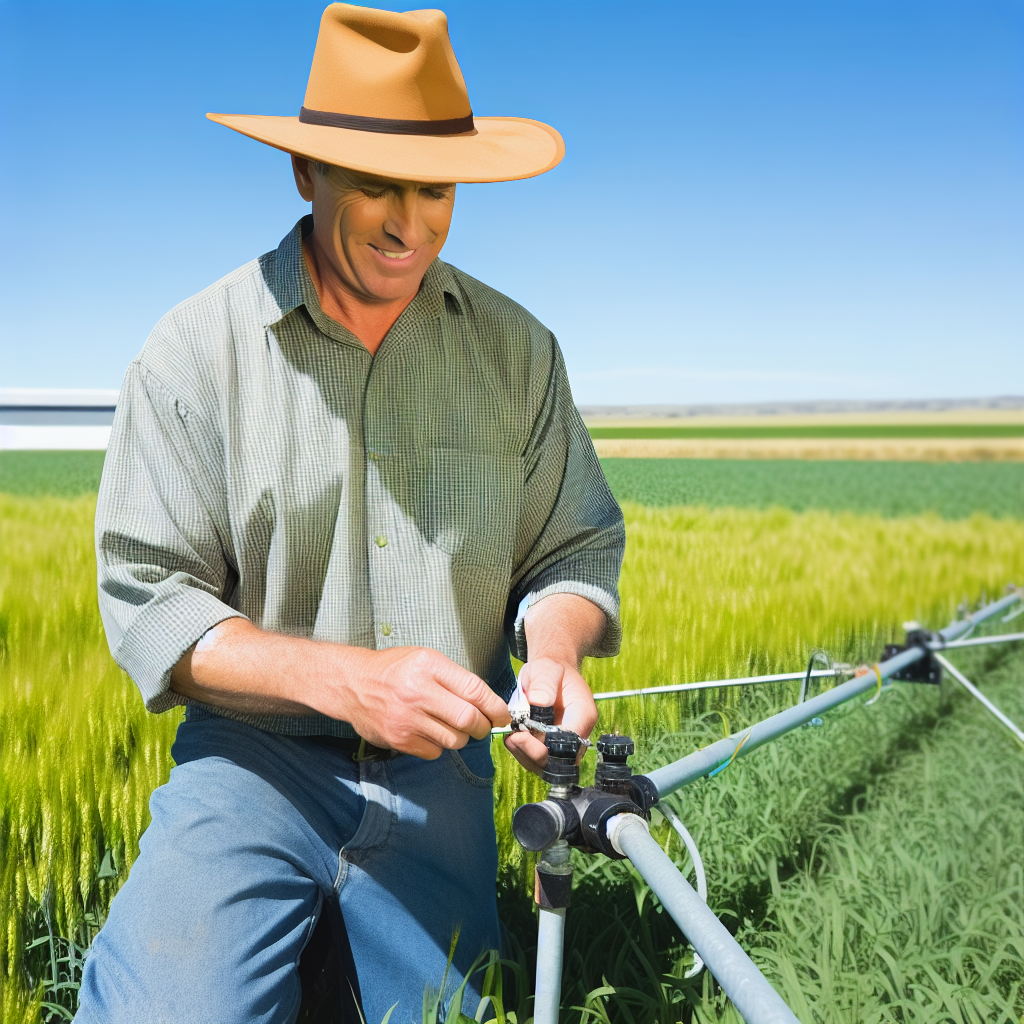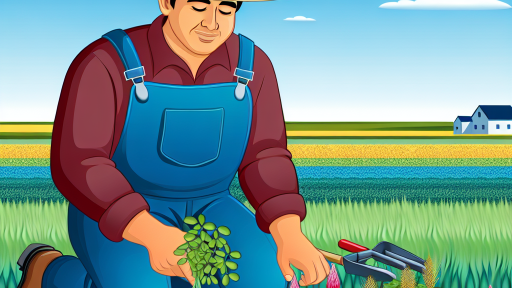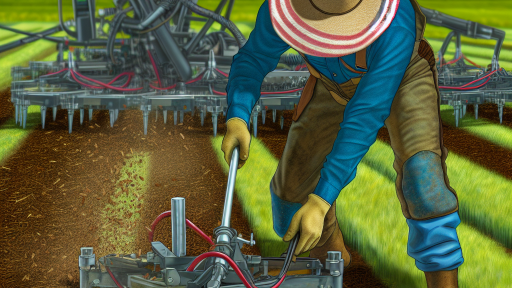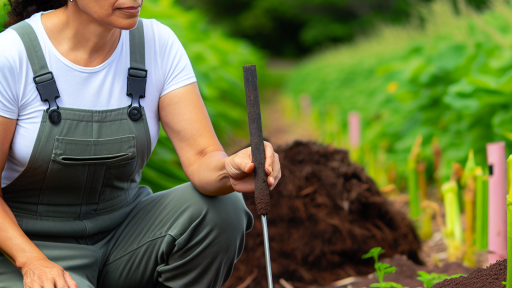Introduction to Water Conservation in Organic Crop Farming
Water conservation plays a crucial role in organic crop farming.
It enhances sustainability and ensures efficient resource use.
Organic farmers face unique challenges in managing water supplies.
Climate change exacerbates these challenges by altering rainfall patterns.
Consequently, farmers must adopt effective water conservation practices.
Importance of Water Conservation
Water is a vital resource for crop growth and soil health.
Conserving water reduces costs and promotes crop resilience.
Additionally, it helps protect local ecosystems from depletion.
Farmers can maintain higher yields through efficient water management.
Best Practices for Water Conservation
Implementing specific techniques enhances water efficiency on farms.
Utilizing drip irrigation allows precise water application.
Rainwater harvesting systems capture and store rainfall effectively.
Cover crops improve soil health and increase moisture retention.
Mulching helps reduce evaporation and suppress weeds.
Technological Innovations
Advancements in technology contribute significantly to water conservation.
Transform Your Agribusiness
Unlock your farm's potential with expert advice tailored to your needs. Get actionable steps that drive real results.
Get StartedSoil moisture sensors enable farmers to monitor water levels.
Automated irrigation systems adjust water supply based on needs.
Using apps, farmers can track weather forecasts and crop requirements.
Implementing these technologies improves overall farm efficiency.
Community Engagement and Education
Farmers benefit from sharing knowledge and experiences within their communities.
Participating in workshops encourages best practices for water management.
Local organizations often provide resources and support for farmers.
Furthermore, education helps raise awareness about conservation efforts.
Collaboration fosters sustainable practices across agricultural sectors.
The Importance of Water Management for Sustainable Agriculture
Essential Role of Water in Crop Production
Water is crucial for healthy crop growth and sustainability.
It facilitates nutrient absorption and photosynthesis.
Without adequate water, crops cannot thrive or produce yields.
Impact of Climate Change on Water Resources
Climate change affects the availability of freshwater resources.
Farmers must adapt their practices to changing precipitation patterns.
This adaptation ensures reliable crop production in new conditions.
Benefits of Effective Water Management
Efficient water management enhances crop resilience.
It reduces water wastage and conserves resources.
Furthermore, it lowers operational costs by optimizing water use.
Practices for Sustainable Water Use
- Implementing drip irrigation systems promotes water efficiency.
- Collecting rainwater provides an alternative water source.
- Utilizing soil moisture sensors allows precise irrigation scheduling.
- Cover cropping reduces erosion and retains soil moisture.
Collaborating with Local Organizations
Farmers can benefit from partnerships with local water agencies.
These collaborations provide resources and support for efficient practices.
Sharing knowledge fosters community-wide water conservation efforts.
Key Water Conservation Techniques
Introduction to Water Conservation
Water conservation is essential for sustainable organic crop farming.
It ensures resources remain available for future generations.
Moreover, it enhances the farm’s resilience to climate variability.
Showcase Your Farming Business
Publish your professional farming services profile on our blog for a one-time fee of $200 and reach a dedicated audience of farmers and agribusiness owners.
Publish Your ProfileMulching Techniques
Mulching helps retain soil moisture effectively.
This practice reduces evaporation by shading the soil.
Organic materials, like straw and leaves, are ideal for mulching.
Additionally, mulching suppresses weed growth, which can compete for water.
Farmers report improved soil health and moisture retention through mulching.
Drip Irrigation Systems
Drip irrigation delivers water directly to the plant roots.
This targeted approach minimizes water loss through evaporation.
It also reduces water runoff, making it highly efficient.
Farmers can adjust flow rates to suit different crops and soil types.
Many find that implementing drip systems leads to healthier plants and higher yields.
Rainwater Harvesting
Rainwater harvesting captures and stores rainwater for later use.
This technique leverages natural precipitation instead of relying solely on wells or municipal supplies.
Setting up collection systems can be relatively low-cost.
Farmers can use harvested water for irrigation during dry spells.
Implementing this practice enhances water availability on the farm.
Crop Rotation and Cover Crops
Crop rotation improves soil structure and moisture retention.
Varying crops replenishes nutrients and helps control pests.
Cover crops, such as clover or rye, protect the soil between seasons.
These crops reduce erosion and enhance water infiltration.
By improving soil health, farmers retain moisture more effectively.
Conservation Tillage
Conservation tillage maintains soil structure and reduces erosion.
This method minimizes soil disruption and enhances water absorption.
Adopting conservation tillage practices can significantly impact water retention.
Farmers notice that less frequent tillage leads to healthier soils.
Impacts of Water Conservation Techniques
Utilizing these water conservation techniques yields numerous benefits.
Farmers can reduce water usage while enhancing crop health.
Ultimately, these practices contribute to sustainable organic farming.
Learn More: Economic Advantages of Using Cover Crops on Farms
Soil Health and Its Role in Water Retention
Understanding Soil Health
Soy health significantly impacts crop productivity and sustainability.
It refers to the condition of soil and its ability to support plant life.
Healthy soil promotes nutrient availability and enhances water retention.
The Structure of Healthy Soil
Soy structure influences water movement and retention capabilities.
Well-structured soil contains spaces for air and water to flow.
This structure also facilitates root growth, contributing to better hydration.
Organic Matter’s Influence
Adding organic matter improves soil health and moisture retention.
Compost, cover crops, and mulches serve as valuable organic amendments.
These materials enhance soil aeration while holding moisture effectively.
Microbial Activity and Water Retention
Healthy soils support diverse microbial communities that aid water retention.
Microorganisms break down organic matter, enriching the soil with nutrients.
Additionally, they create soil aggregates that improve moisture-holding capacity.
Showcase Your Farming Business
Publish your professional farming services profile on our blog for a one-time fee of $200 and reach a dedicated audience of farmers and agribusiness owners.
Publish Your ProfileWater-Absorbing Technologies
Farmers can implement various techniques to improve water retention.
- Incorporating biochar can enhance soil structure.
- Using rainwater harvesting systems captures excess rain for irrigation.
- The use of drip irrigation helps minimize water evaporation.
Crop Selection and Management
Choosing appropriate crop varieties can aid in water retention.
Drought-resistant plants often require less water and thrive in variable conditions.
Additionally, adopting crop rotation enhances soil health and reduces water stress.
Cover Cropping Practices
Cover crops provide numerous benefits, including improved water retention.
These plants protect the soil from erosion while building organic matter.
They also enhance soil structure, fostering better water infiltration.
Benefits of Soil Conservation Practices
Implementing soil conservation practices yields long-term benefits.
- Conserves water, reducing the need for irrigation.
- Enhances crop resilience to climate fluctuations.
- Promotes sustainable agricultural practices improving yields.
You Might Also Like: Seasonal Trends In Pest And Disease Forecasting
Irrigation Practices: Drip Irrigation vs. Traditional Methods
Overview of Irrigation Methods
Irrigation is vital for crop farming.
Different methods exist to deliver water efficiently.
Farmers must choose the method that suits their needs.
Drip irrigation and traditional methods are popular options.
Understanding Drip Irrigation
Drip irrigation delivers water directly to plant roots.
This system uses a network of tubing and emitters.
It minimizes evaporation and runoff effectively.
Furthermore, it allows for precise water application.
Benefits of Drip Irrigation
- It conserves water by preventing over-irrigation.
- Crops receive water directly, enhancing growth.
- It reduces weed growth by watering only the plants.
- Farmers can monitor and adjust water levels easily.
Challenges of Drip Irrigation
While beneficial, drip irrigation has its challenges.
The initial installation cost can be high.
Regular maintenance is essential to prevent clogging.
Additionally, training may be needed to operate systems effectively.
Examining Traditional Irrigation Methods
Traditional methods include surface, sprinkler, and flood irrigation.
Surface irrigation uses gravity to move water across fields.
Sprinkler systems simulate rainfall by spraying water.
Flood irrigation involves covering fields with water.
Benefits of Traditional Methods
- Initial setup costs are often lower than drip systems.
- They can be easier to understand and operate.
- Surface irrigation can benefit specific crop types.
Challenges of Traditional Methods
Traditional methods often waste water through runoff and evaporation.
Inconsistent water distribution can happen across fields.
This inconsistency can lead to uneven crop growth.
Comparative Analysis
Both drip irrigation and traditional methods have pros and cons.
Farmers must consider their specific crop needs.
They should also assess the local climate and water availability.
Ultimately, the goal is effective water management for sustainability.
You Might Also Like: Integrating Nutrient Management on Your Farm
Use of Cover Crops to Reduce Water Loss
Definition and Purpose
Cover crops are plants grown primarily to benefit the soil.
They provide ground cover that protects the soil from erosion.
Moreover, they help retain moisture in the soil.
This practice is especially useful during dry periods.
Types of Cover Crops
Various cover crops can be used for different benefits.
Leguminous cover crops, like clover, fix nitrogen in the soil.
Additionally, grasses such as rye can improve soil structure.
Showcase Your Farming Business
Publish your professional farming services profile on our blog for a one-time fee of $200 and reach a dedicated audience of farmers and agribusiness owners.
Publish Your ProfileBrassicas, like radishes, enhance soil drainage and biomass.
How Cover Crops Conserve Water
Cover crops reduce evaporation rates from the soil surface.
They also improve infiltration, allowing more water to penetrate.
As a result, these crops help maintain soil moisture levels.
This is particularly vital in organic crop farming.
Best Practices for Implementing Cover Crops
Farmers should select appropriate cover crops based on their needs.
It’s crucial to plant them at the right time for maximum effect.
Integrating cover crops into crop rotation also provides benefits.
Regular soil assessments help determine the best options.
Success Stories
Many farmers have successfully adopted cover crops.
For instance, Maria Johnson from Willow Farm experienced improved yields.
She noted a significant decrease in irrigation needs.
Similarly, Green Valley Farms reported enhanced soil health.
Challenges and Considerations
Despite their benefits, cover crops require careful management.
Some may compete with cash crops for nutrients.
Farmers need to balance cover and cash crops effectively.
Furthermore, initial costs may deter some farmers.
However, the long-term benefits often outweigh these challenges.
See Related Content: Cover Cropping Techniques for Organic Farming

Rainwater Harvesting: Techniques and Implementation
Understanding Rainwater Harvesting
Rainwater harvesting involves collecting and storing rainfall for agricultural use.
This technique reduces dependence on traditional water sources.
Farmers can use harvested rainwater for irrigation and livestock.
Moreover, it helps conserve groundwater resources.
Benefits of Rainwater Harvesting
This practice offers numerous advantages for organic crop farming.
First, it lowers water bills significantly.
Secondly, it mitigates flooding and erosion risks.
Additionally, harvested rainwater is usually free of chemicals.
This makes it a healthier option for crops.
Harvesting Techniques
There are various techniques for harvesting rainwater effectively.
One common method is rooftop collection.
This involves directing water from roofs into storage tanks.
Another technique is contour farming.
This method channels rainwater along the land’s contours, minimizing runoff.
Implementing a Harvesting System
Implementing a rainwater harvesting system follows several steps.
First, assess the available space and rainfall patterns.
Next, choose appropriate storage tanks.
For example, larger tanks are ideal for extensive farms.
Moreover, ensure proper filtration systems are in place.
Maintenance and Management
Regular maintenance is crucial for optimal performance.
Clean gutters and storage tanks periodically to prevent contamination.
Showcase Your Farming Business
Publish your professional farming services profile on our blog for a one-time fee of $200 and reach a dedicated audience of farmers and agribusiness owners.
Publish Your ProfileAdditionally, check for leaks in the system.
Farmers should monitor water levels and usage frequently.
Real-World Examples
Many successful farms incorporate rainwater harvesting.
For instance, Green Acres Farm in California utilizes this method.
They have reported significant increases in crop yields.
Similarly, Blue Sky Organics in Texas maximizes its irrigation efficiency.
They collect rainwater to cater to their diverse crops.
Case Studies: Successful Organic Farms Implementing Water Conservation
Green Meadows Farm: Innovative Irrigation Systems
Green Meadows Farm successfully improves water efficiency through innovative irrigation systems.
They utilize drip irrigation to minimize water waste.
This system delivers water directly to the plant roots.
As a result, they have reduced their water usage by 30% annually.
Furthermore, the farm captures rainwater for irrigation use.
This practice ensures sustainability and reduces dependence on groundwater.
Sunny Acres Organic Farm: Soil Management Techniques
Sunny Acres Organic Farm emphasizes soil management to enhance water retention.
The farm implements cover cropping to protect the soil.
These crops help maintain moisture levels in the ground.
Moreover, they practice no-till farming to protect soil structure.
This approach significantly reduces erosion and improves water absorption.
Consequently, they see healthier crops with less irrigation demand.
Harvest & Hope: Community Engagement and Education
Harvest & Hope focuses on community engagement and education regarding water conservation.
The farm offers workshops to local farmers on sustainable practices.
Participants learn about efficient water use and crop rotation techniques.
This initiative fosters a collaborative approach to water conservation.
Additionally, they provide resources for rainwater harvest systems.
Such efforts create a more resilient agricultural community.
Mountain View Organic Farms: Advanced Technology Use
Mountain View Organic Farms leverages technology to conserve water effectively.
They use soil moisture sensors to monitor irrigation needs.
This technology helps adjust water application based on crop requirements.
Consequently, they avoid over-irrigation and promote efficient water use.
Moreover, the farm employs mobile apps to track weather patterns.
This ensures timely irrigation scheduling aligned with forecasted rain.
Ocean Breeze Farm: Integrated Pest Management
Ocean Breeze Farm integrates pest management strategies to conserve water.
By maintaining healthy soils, they promote water retention.
They also use biocontrol agents to manage pest populations sustainably.
This reduces the need for excessive water applications in pest control.
Moreover, their efforts lead to healthier ecosystems surrounding the farm.
Seeing positive outcomes, they inspire neighboring farms to adopt similar methods.
Challenges and Solutions in Water Conservation for Organic Farmers
Understanding Water Scarcity
Water scarcity poses a significant challenge for organic farmers.
Climate change exacerbates this issue by altering precipitation patterns.
Consequently, farmers must adapt their practices to manage water more effectively.
Showcase Your Farming Business
Publish your professional farming services profile on our blog for a one-time fee of $200 and reach a dedicated audience of farmers and agribusiness owners.
Publish Your ProfileImproving Soil Health
Healthy soil retains moisture better than degraded soil.
Organic practices such as cover cropping enhance soil structure.
Additionally, composting increases organic matter content.
These practices ultimately improve water retention capabilities.
Efficient Irrigation Techniques
Implementing efficient irrigation systems can significantly reduce water usage.
Drip irrigation delivers water directly to the plant roots.
This method minimizes evaporation and runoff.
Farmers can also use rainwater harvesting techniques.
Capturing rainwater helps conserve precious resources.
Utilizing Mulching Practices
Mulching is another effective water conservation practice.
Applying organic mulch reduces surface evaporation.
It also suppresses weeds that compete for moisture.
Therefore, farmers can maintain optimal soil moisture levels.
Monitoring and Adapting Practices
Farmers should regularly monitor soil moisture levels.
This information enables timely irrigation adjustments.
Furthermore, utilizing technology can enhance monitoring efforts.
Soil moisture sensors provide real-time data for better decisions.
Community and Knowledge Sharing
Collaboration can lead to innovative solutions in water conservation.
Farmers can join local cooperatives to exchange water-saving techniques.
Sharing resources fosters a sustainable farming community.
Education and workshops can further empower farmers with knowledge.




